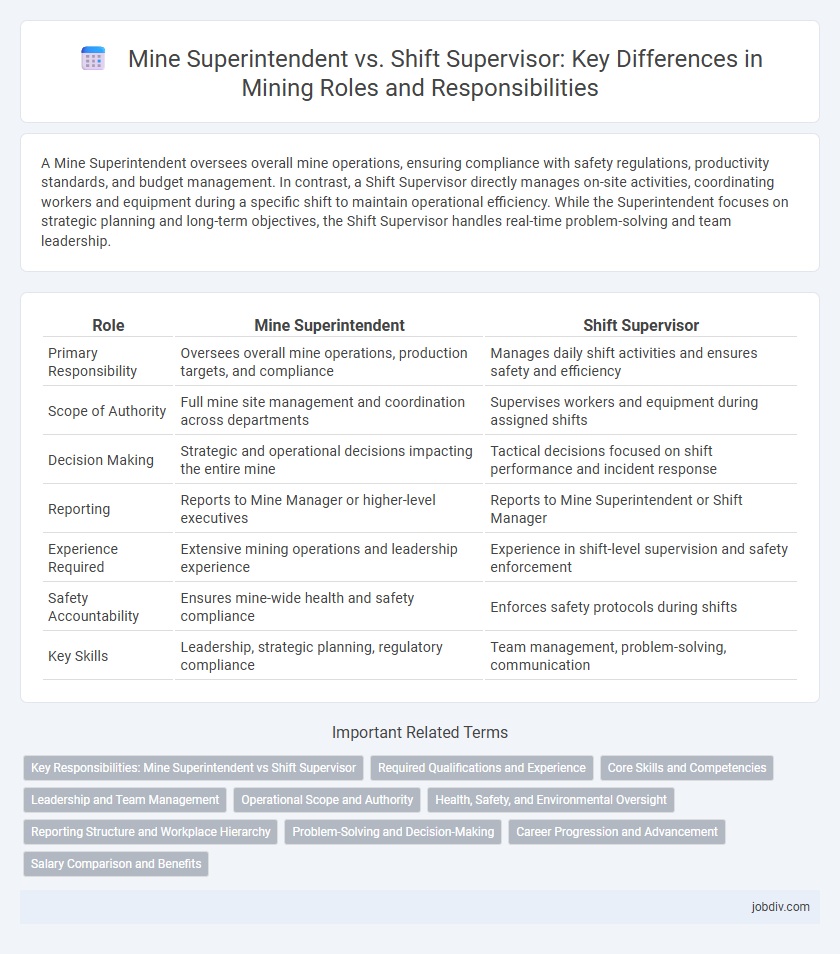A Mine Superintendent oversees overall mine operations, ensuring compliance with safety regulations, productivity standards, and budget management. In contrast, a Shift Supervisor directly manages on-site activities, coordinating workers and equipment during a specific shift to maintain operational efficiency. While the Superintendent focuses on strategic planning and long-term objectives, the Shift Supervisor handles real-time problem-solving and team leadership.
Table of Comparison
| Role | Mine Superintendent | Shift Supervisor |
|---|---|---|
| Primary Responsibility | Oversees overall mine operations, production targets, and compliance | Manages daily shift activities and ensures safety and efficiency |
| Scope of Authority | Full mine site management and coordination across departments | Supervises workers and equipment during assigned shifts |
| Decision Making | Strategic and operational decisions impacting the entire mine | Tactical decisions focused on shift performance and incident response |
| Reporting | Reports to Mine Manager or higher-level executives | Reports to Mine Superintendent or Shift Manager |
| Experience Required | Extensive mining operations and leadership experience | Experience in shift-level supervision and safety enforcement |
| Safety Accountability | Ensures mine-wide health and safety compliance | Enforces safety protocols during shifts |
| Key Skills | Leadership, strategic planning, regulatory compliance | Team management, problem-solving, communication |
Key Responsibilities: Mine Superintendent vs Shift Supervisor
Mine Superintendents oversee overall mine operations, including planning, safety compliance, budgeting, and coordination of multiple shifts to ensure production targets are met. Shift Supervisors manage day-to-day operational activities during their assigned shifts, focusing on workforce supervision, immediate problem-solving, equipment maintenance, and enforcing safety protocols on site. Both roles are pivotal for operational efficiency but differ in scope, with Superintendents handling strategic management and Shift Supervisors executing tactical supervision.
Required Qualifications and Experience
Mine Superintendents typically require a Bachelor's degree in Mining Engineering or a related field, along with over 10 years of experience in mine operations management. Shift Supervisors often hold a technical diploma or associate degree in mining technology with 3 to 5 years of hands-on experience in underground or surface mine supervision. Both roles demand strong knowledge of safety regulations and operational procedures, but Superintendents must demonstrate advanced leadership skills and strategic planning expertise for large-scale mining projects.
Core Skills and Competencies
Mine Superintendents possess advanced leadership skills, strategic planning abilities, and comprehensive knowledge of mining operations, safety regulations, and compliance management. Shift Supervisors demonstrate strong operational oversight, real-time problem-solving skills, and effective team coordination to ensure smooth and safe shift execution. Both roles require proficiency in risk assessment, resource allocation, and communication, but Mine Superintendents emphasize long-term project management while Shift Supervisors focus on immediate operational control.
Leadership and Team Management
The Mine Superintendent oversees overall site operations, emphasizing strategic leadership and coordination among multiple teams to ensure safety and productivity. The Shift Supervisor manages daily team activities on the ground, directly supervising miners and monitoring compliance with operational standards to maintain efficient workflow. Both roles require strong leadership and team management skills but differ in scope, with the Superintendent focusing on high-level planning and the Supervisor on frontline execution.
Operational Scope and Authority
A Mine Superintendent typically holds broader operational authority, overseeing entire mining operations, strategic planning, and regulatory compliance across all shifts. The Shift Supervisor manages specific shifts, ensuring production targets, safety protocols, and day-to-day workforce coordination are met within their assigned timeframe. While the Superintendent drives overall mine productivity and long-term goals, the Shift Supervisor controls immediate operational execution and issue resolution on the ground.
Health, Safety, and Environmental Oversight
Mine Superintendents hold ultimate responsibility for the health, safety, and environmental compliance across the entire mining site, implementing comprehensive policies and ensuring regulatory adherence. Shift Supervisors focus on real-time monitoring and enforcement of safety protocols during their shifts, addressing immediate hazards and coordinating emergency responses. Both roles collaborate to maintain a safe work environment, with the Superintendent overseeing strategic planning while Supervisors manage operational execution.
Reporting Structure and Workplace Hierarchy
The Mine Superintendent typically holds a higher position in the workplace hierarchy, overseeing multiple shift supervisors and coordinating overall mine operations. Shift Supervisors report directly to the Mine Superintendent, managing day-to-day activities and workforce within their designated shifts. This reporting structure ensures effective communication and operational control across the mining site.
Problem-Solving and Decision-Making
Mine Superintendents oversee strategic problem-solving and high-level decision-making to optimize mine operations, ensuring long-term productivity and safety compliance. Shift Supervisors handle immediate operational issues on-site, making quick decisions to address daily challenges and maintain workflow continuity. Both roles require strong analytical skills but differ in scope, with Superintendents focusing on planning and policy, while Supervisors manage real-time problem resolution.
Career Progression and Advancement
A Mine Superintendent typically oversees entire mining operations, managing safety, production, and compliance, positioning them for senior executive roles such as Mining Manager or Operations Director. Shift Supervisors focus on coordinating daily mining activities and frontline worker supervision, providing essential operational experience that serves as a stepping stone toward superintendent positions. Career advancement from Shift Supervisor to Mine Superintendent requires expertise in regulatory standards, leadership in large-scale operations, and strategic planning within the mining industry.
Salary Comparison and Benefits
Mine Superintendents typically earn higher salaries compared to Shift Supervisors due to their greater responsibilities in overseeing entire mining operations and managing multiple teams. Benefits for Mine Superintendents often include comprehensive health insurance, retirement plans, and performance bonuses, whereas Shift Supervisors usually receive standard benefits such as health coverage and shift differentials. Salary ranges for Mine Superintendents are generally between $90,000 and $140,000 annually, while Shift Supervisors earn approximately $60,000 to $90,000 per year, reflecting their differing managerial roles.
Mine Superintendent vs Shift Supervisor Infographic

 jobdiv.com
jobdiv.com